Aged Care Complaints in Australia: A Case Study to Improve the Aged Care Facility
VerifiedAdded on 2023/06/13
|6
|1256
|383
AI Summary
The research aims to investigate the underlying reason behind the drop in the quality of care in the aged care facility in Australia. The study will follow mixed methodology, including secondary data analysis and primary data collection via face-to-face interviews. The research objectives include lack of trained nurse, high turn-over rate among the nurses, and untrained doctors affecting the quality of aged care.
Contribute Materials
Your contribution can guide someone’s learning journey. Share your
documents today.
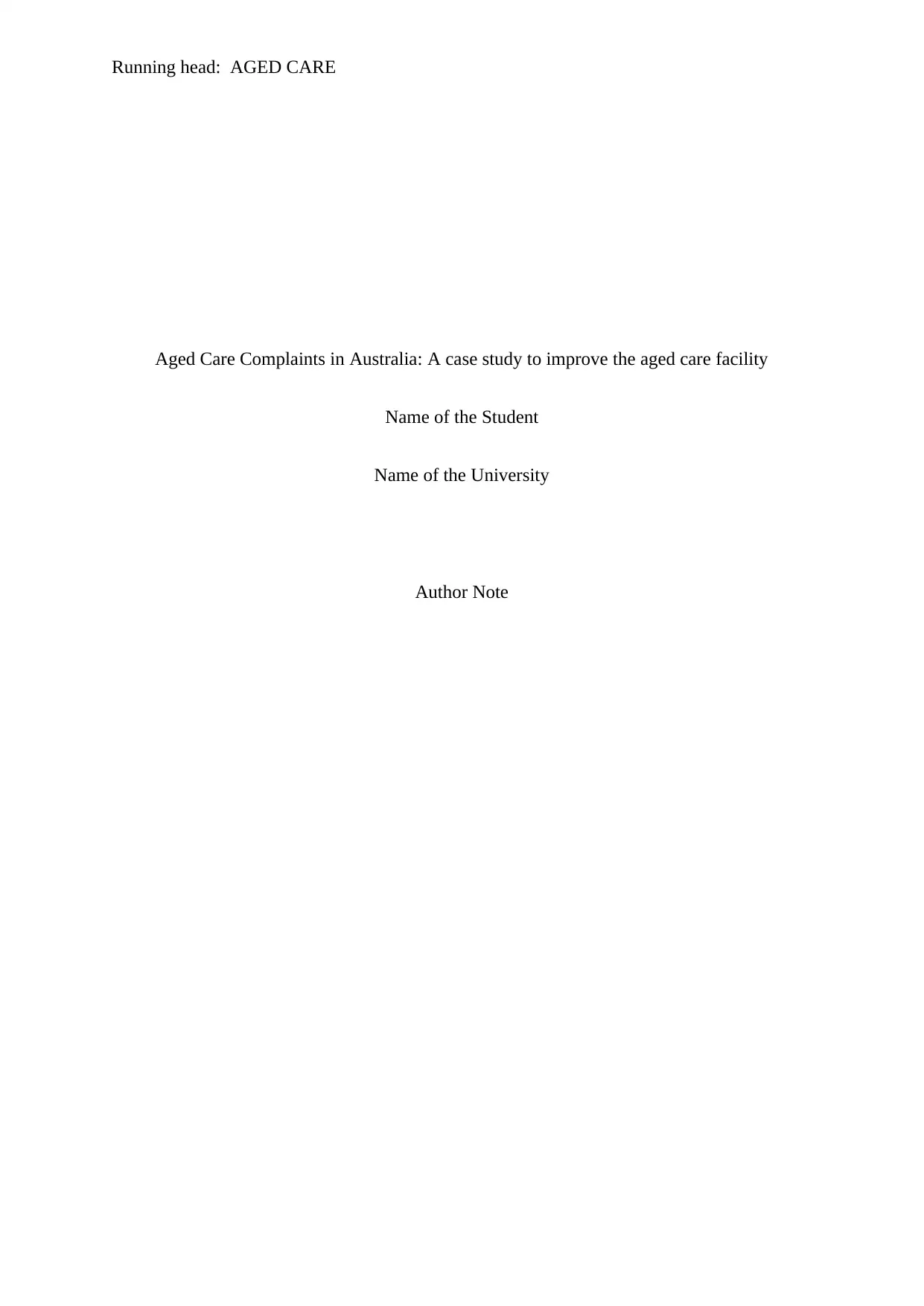
Running head: AGED CARE
Aged Care Complaints in Australia: A case study to improve the aged care facility
Name of the Student
Name of the University
Author Note
Aged Care Complaints in Australia: A case study to improve the aged care facility
Name of the Student
Name of the University
Author Note
Secure Best Marks with AI Grader
Need help grading? Try our AI Grader for instant feedback on your assignments.
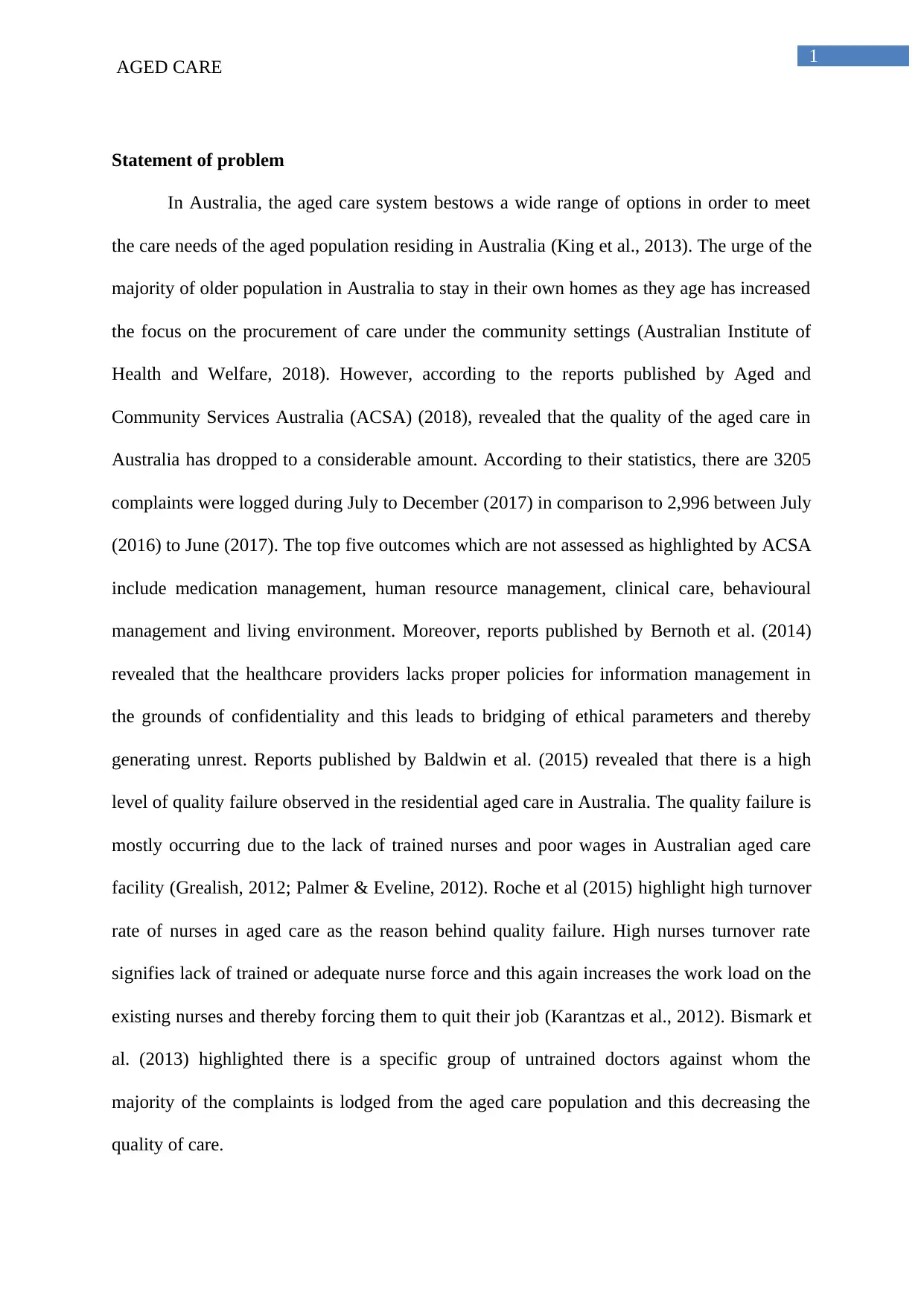
1
AGED CARE
Statement of problem
In Australia, the aged care system bestows a wide range of options in order to meet
the care needs of the aged population residing in Australia (King et al., 2013). The urge of the
majority of older population in Australia to stay in their own homes as they age has increased
the focus on the procurement of care under the community settings (Australian Institute of
Health and Welfare, 2018). However, according to the reports published by Aged and
Community Services Australia (ACSA) (2018), revealed that the quality of the aged care in
Australia has dropped to a considerable amount. According to their statistics, there are 3205
complaints were logged during July to December (2017) in comparison to 2,996 between July
(2016) to June (2017). The top five outcomes which are not assessed as highlighted by ACSA
include medication management, human resource management, clinical care, behavioural
management and living environment. Moreover, reports published by Bernoth et al. (2014)
revealed that the healthcare providers lacks proper policies for information management in
the grounds of confidentiality and this leads to bridging of ethical parameters and thereby
generating unrest. Reports published by Baldwin et al. (2015) revealed that there is a high
level of quality failure observed in the residential aged care in Australia. The quality failure is
mostly occurring due to the lack of trained nurses and poor wages in Australian aged care
facility (Grealish, 2012; Palmer & Eveline, 2012). Roche et al (2015) highlight high turnover
rate of nurses in aged care as the reason behind quality failure. High nurses turnover rate
signifies lack of trained or adequate nurse force and this again increases the work load on the
existing nurses and thereby forcing them to quit their job (Karantzas et al., 2012). Bismark et
al. (2013) highlighted there is a specific group of untrained doctors against whom the
majority of the complaints is lodged from the aged care population and this decreasing the
quality of care.
AGED CARE
Statement of problem
In Australia, the aged care system bestows a wide range of options in order to meet
the care needs of the aged population residing in Australia (King et al., 2013). The urge of the
majority of older population in Australia to stay in their own homes as they age has increased
the focus on the procurement of care under the community settings (Australian Institute of
Health and Welfare, 2018). However, according to the reports published by Aged and
Community Services Australia (ACSA) (2018), revealed that the quality of the aged care in
Australia has dropped to a considerable amount. According to their statistics, there are 3205
complaints were logged during July to December (2017) in comparison to 2,996 between July
(2016) to June (2017). The top five outcomes which are not assessed as highlighted by ACSA
include medication management, human resource management, clinical care, behavioural
management and living environment. Moreover, reports published by Bernoth et al. (2014)
revealed that the healthcare providers lacks proper policies for information management in
the grounds of confidentiality and this leads to bridging of ethical parameters and thereby
generating unrest. Reports published by Baldwin et al. (2015) revealed that there is a high
level of quality failure observed in the residential aged care in Australia. The quality failure is
mostly occurring due to the lack of trained nurses and poor wages in Australian aged care
facility (Grealish, 2012; Palmer & Eveline, 2012). Roche et al (2015) highlight high turnover
rate of nurses in aged care as the reason behind quality failure. High nurses turnover rate
signifies lack of trained or adequate nurse force and this again increases the work load on the
existing nurses and thereby forcing them to quit their job (Karantzas et al., 2012). Bismark et
al. (2013) highlighted there is a specific group of untrained doctors against whom the
majority of the complaints is lodged from the aged care population and this decreasing the
quality of care.
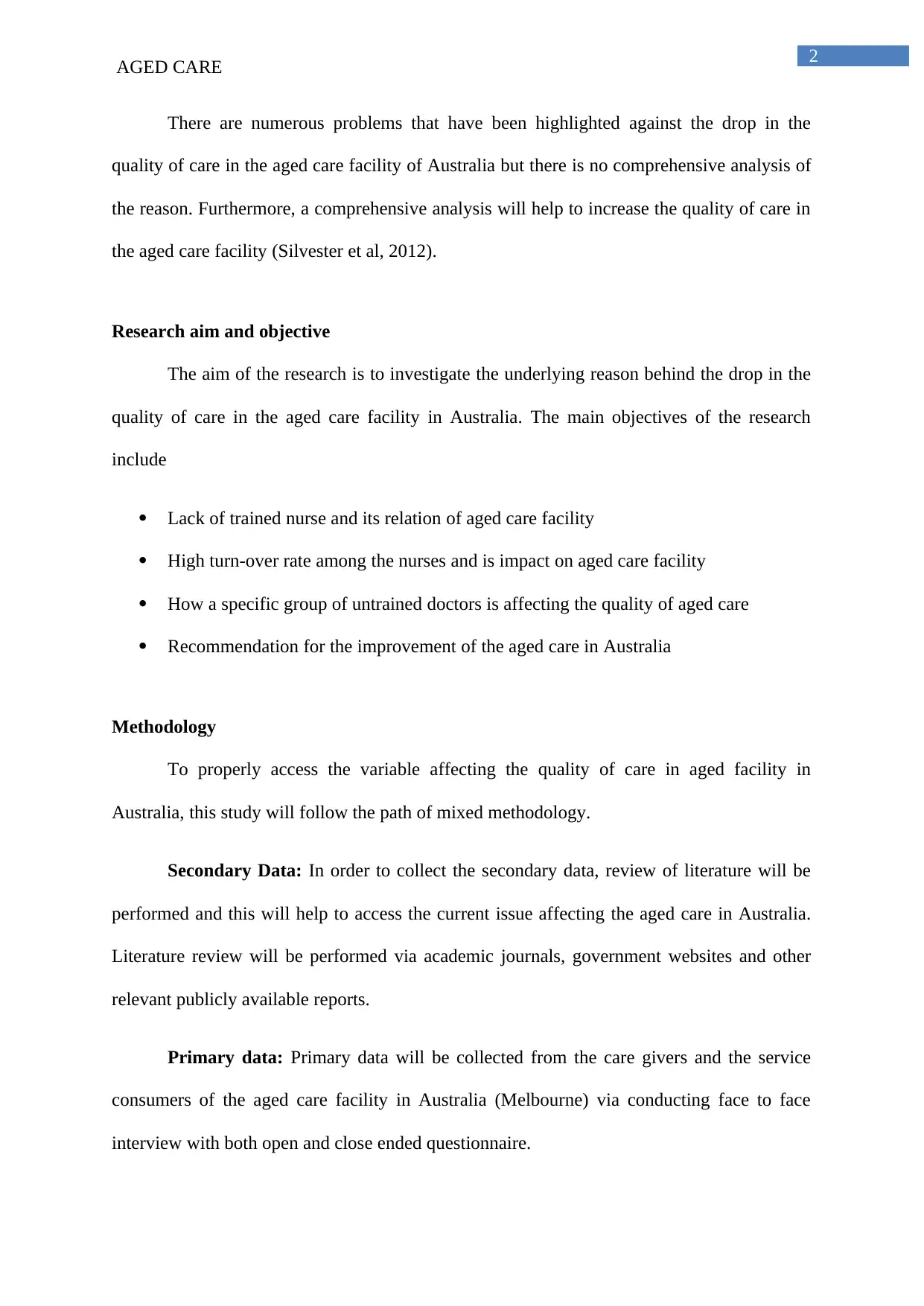
2
AGED CARE
There are numerous problems that have been highlighted against the drop in the
quality of care in the aged care facility of Australia but there is no comprehensive analysis of
the reason. Furthermore, a comprehensive analysis will help to increase the quality of care in
the aged care facility (Silvester et al, 2012).
Research aim and objective
The aim of the research is to investigate the underlying reason behind the drop in the
quality of care in the aged care facility in Australia. The main objectives of the research
include
Lack of trained nurse and its relation of aged care facility
High turn-over rate among the nurses and is impact on aged care facility
How a specific group of untrained doctors is affecting the quality of aged care
Recommendation for the improvement of the aged care in Australia
Methodology
To properly access the variable affecting the quality of care in aged facility in
Australia, this study will follow the path of mixed methodology.
Secondary Data: In order to collect the secondary data, review of literature will be
performed and this will help to access the current issue affecting the aged care in Australia.
Literature review will be performed via academic journals, government websites and other
relevant publicly available reports.
Primary data: Primary data will be collected from the care givers and the service
consumers of the aged care facility in Australia (Melbourne) via conducting face to face
interview with both open and close ended questionnaire.
AGED CARE
There are numerous problems that have been highlighted against the drop in the
quality of care in the aged care facility of Australia but there is no comprehensive analysis of
the reason. Furthermore, a comprehensive analysis will help to increase the quality of care in
the aged care facility (Silvester et al, 2012).
Research aim and objective
The aim of the research is to investigate the underlying reason behind the drop in the
quality of care in the aged care facility in Australia. The main objectives of the research
include
Lack of trained nurse and its relation of aged care facility
High turn-over rate among the nurses and is impact on aged care facility
How a specific group of untrained doctors is affecting the quality of aged care
Recommendation for the improvement of the aged care in Australia
Methodology
To properly access the variable affecting the quality of care in aged facility in
Australia, this study will follow the path of mixed methodology.
Secondary Data: In order to collect the secondary data, review of literature will be
performed and this will help to access the current issue affecting the aged care in Australia.
Literature review will be performed via academic journals, government websites and other
relevant publicly available reports.
Primary data: Primary data will be collected from the care givers and the service
consumers of the aged care facility in Australia (Melbourne) via conducting face to face
interview with both open and close ended questionnaire.

3
AGED CARE
Secondary data and data analysis
Analysis of the secondary data will be done via thematic analysis and primary data
analysis will be done via quantitative analysis through well structured excel sheet. Then the
correlation analysis will be done in order to find relationship between the dependent variable
(poor of aged care facility) and independent variable (role of nurse/ role of doctors).
AGED CARE
Secondary data and data analysis
Analysis of the secondary data will be done via thematic analysis and primary data
analysis will be done via quantitative analysis through well structured excel sheet. Then the
correlation analysis will be done in order to find relationship between the dependent variable
(poor of aged care facility) and independent variable (role of nurse/ role of doctors).
Secure Best Marks with AI Grader
Need help grading? Try our AI Grader for instant feedback on your assignments.
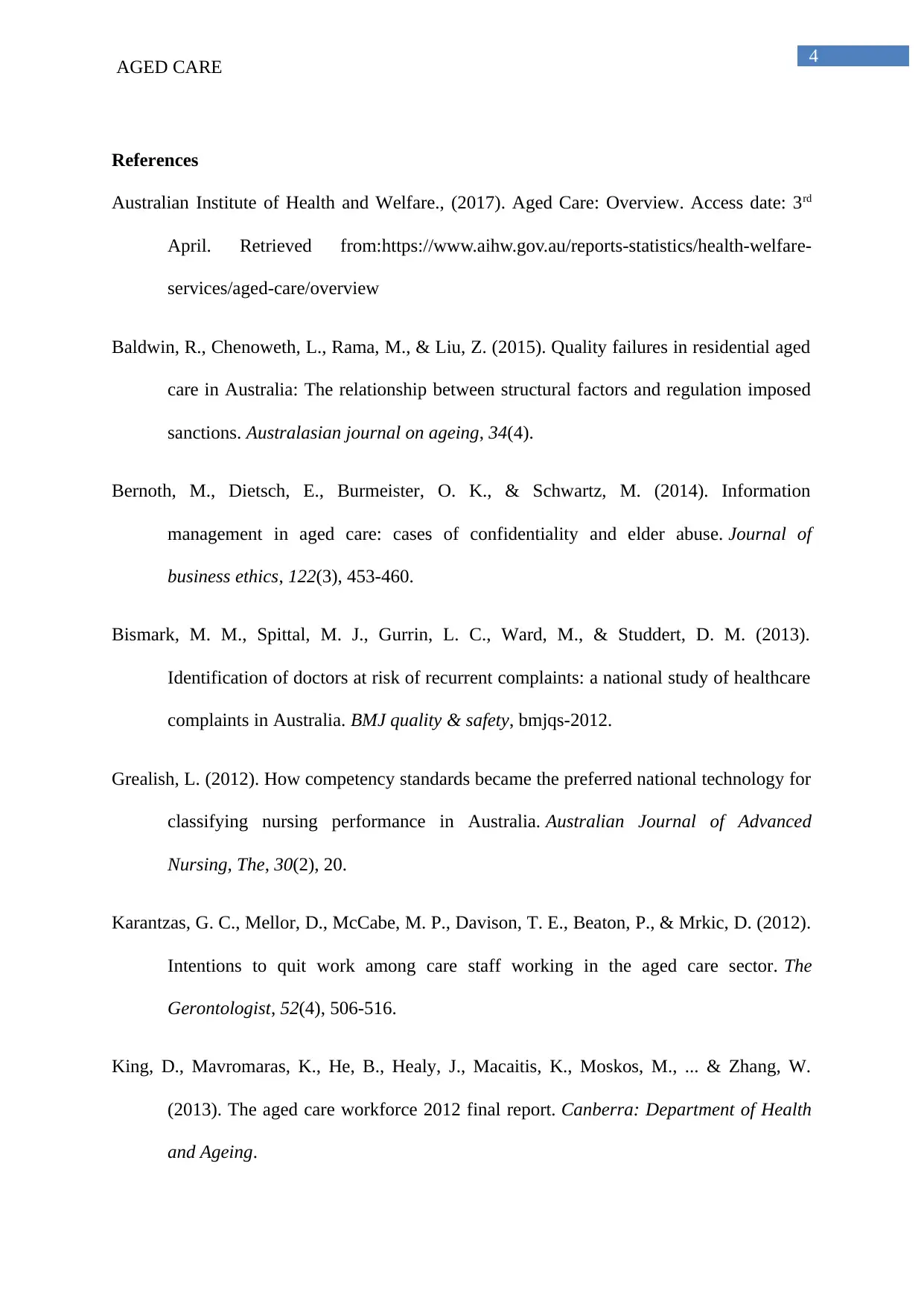
4
AGED CARE
References
Australian Institute of Health and Welfare., (2017). Aged Care: Overview. Access date: 3rd
April. Retrieved from:https://www.aihw.gov.au/reports-statistics/health-welfare-
services/aged-care/overview
Baldwin, R., Chenoweth, L., Rama, M., & Liu, Z. (2015). Quality failures in residential aged
care in Australia: The relationship between structural factors and regulation imposed
sanctions. Australasian journal on ageing, 34(4).
Bernoth, M., Dietsch, E., Burmeister, O. K., & Schwartz, M. (2014). Information
management in aged care: cases of confidentiality and elder abuse. Journal of
business ethics, 122(3), 453-460.
Bismark, M. M., Spittal, M. J., Gurrin, L. C., Ward, M., & Studdert, D. M. (2013).
Identification of doctors at risk of recurrent complaints: a national study of healthcare
complaints in Australia. BMJ quality & safety, bmjqs-2012.
Grealish, L. (2012). How competency standards became the preferred national technology for
classifying nursing performance in Australia. Australian Journal of Advanced
Nursing, The, 30(2), 20.
Karantzas, G. C., Mellor, D., McCabe, M. P., Davison, T. E., Beaton, P., & Mrkic, D. (2012).
Intentions to quit work among care staff working in the aged care sector. The
Gerontologist, 52(4), 506-516.
King, D., Mavromaras, K., He, B., Healy, J., Macaitis, K., Moskos, M., ... & Zhang, W.
(2013). The aged care workforce 2012 final report. Canberra: Department of Health
and Ageing.
AGED CARE
References
Australian Institute of Health and Welfare., (2017). Aged Care: Overview. Access date: 3rd
April. Retrieved from:https://www.aihw.gov.au/reports-statistics/health-welfare-
services/aged-care/overview
Baldwin, R., Chenoweth, L., Rama, M., & Liu, Z. (2015). Quality failures in residential aged
care in Australia: The relationship between structural factors and regulation imposed
sanctions. Australasian journal on ageing, 34(4).
Bernoth, M., Dietsch, E., Burmeister, O. K., & Schwartz, M. (2014). Information
management in aged care: cases of confidentiality and elder abuse. Journal of
business ethics, 122(3), 453-460.
Bismark, M. M., Spittal, M. J., Gurrin, L. C., Ward, M., & Studdert, D. M. (2013).
Identification of doctors at risk of recurrent complaints: a national study of healthcare
complaints in Australia. BMJ quality & safety, bmjqs-2012.
Grealish, L. (2012). How competency standards became the preferred national technology for
classifying nursing performance in Australia. Australian Journal of Advanced
Nursing, The, 30(2), 20.
Karantzas, G. C., Mellor, D., McCabe, M. P., Davison, T. E., Beaton, P., & Mrkic, D. (2012).
Intentions to quit work among care staff working in the aged care sector. The
Gerontologist, 52(4), 506-516.
King, D., Mavromaras, K., He, B., Healy, J., Macaitis, K., Moskos, M., ... & Zhang, W.
(2013). The aged care workforce 2012 final report. Canberra: Department of Health
and Ageing.
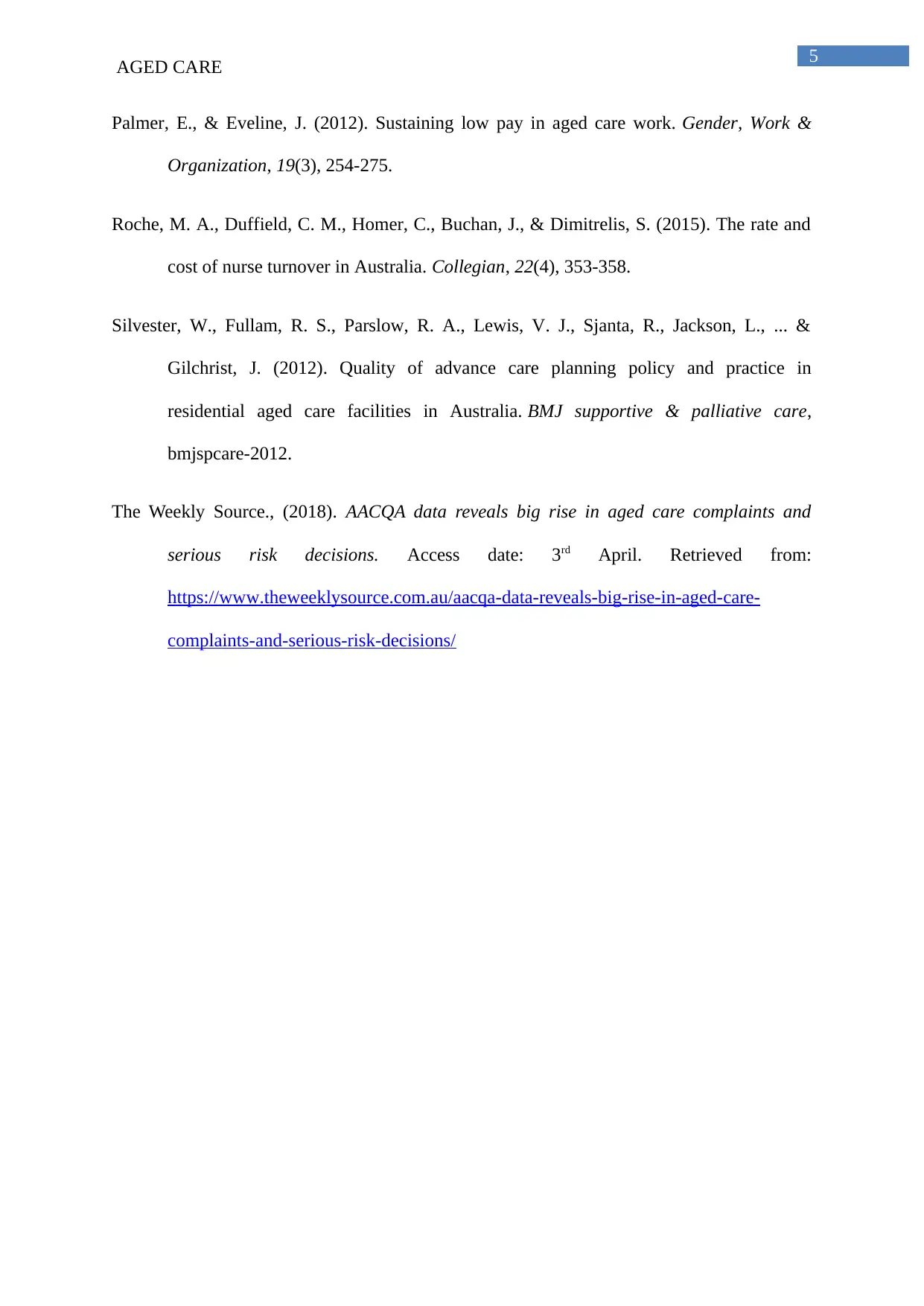
5
AGED CARE
Palmer, E., & Eveline, J. (2012). Sustaining low pay in aged care work. Gender, Work &
Organization, 19(3), 254-275.
Roche, M. A., Duffield, C. M., Homer, C., Buchan, J., & Dimitrelis, S. (2015). The rate and
cost of nurse turnover in Australia. Collegian, 22(4), 353-358.
Silvester, W., Fullam, R. S., Parslow, R. A., Lewis, V. J., Sjanta, R., Jackson, L., ... &
Gilchrist, J. (2012). Quality of advance care planning policy and practice in
residential aged care facilities in Australia. BMJ supportive & palliative care,
bmjspcare-2012.
The Weekly Source., (2018). AACQA data reveals big rise in aged care complaints and
serious risk decisions. Access date: 3rd April. Retrieved from:
https://www.theweeklysource.com.au/aacqa-data-reveals-big-rise-in-aged-care-
complaints-and-serious-risk-decisions/
AGED CARE
Palmer, E., & Eveline, J. (2012). Sustaining low pay in aged care work. Gender, Work &
Organization, 19(3), 254-275.
Roche, M. A., Duffield, C. M., Homer, C., Buchan, J., & Dimitrelis, S. (2015). The rate and
cost of nurse turnover in Australia. Collegian, 22(4), 353-358.
Silvester, W., Fullam, R. S., Parslow, R. A., Lewis, V. J., Sjanta, R., Jackson, L., ... &
Gilchrist, J. (2012). Quality of advance care planning policy and practice in
residential aged care facilities in Australia. BMJ supportive & palliative care,
bmjspcare-2012.
The Weekly Source., (2018). AACQA data reveals big rise in aged care complaints and
serious risk decisions. Access date: 3rd April. Retrieved from:
https://www.theweeklysource.com.au/aacqa-data-reveals-big-rise-in-aged-care-
complaints-and-serious-risk-decisions/
1 out of 6
Related Documents
Your All-in-One AI-Powered Toolkit for Academic Success.
+13062052269
info@desklib.com
Available 24*7 on WhatsApp / Email
![[object Object]](/_next/static/media/star-bottom.7253800d.svg)
Unlock your academic potential
© 2024 | Zucol Services PVT LTD | All rights reserved.





